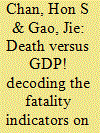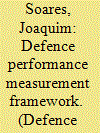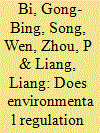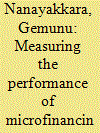|
|
|
Sort Order |
|
|
|
Items / Page
|
|
|
|
|
|
|
| Srl | Item |
| 1 |
ID:
149744


|
|
|
|
|
| Summary/Abstract |
The deliberate distortion of the work accomplishments of local governments is a growing concern for China's leaders in the reform era. How do they tackle this problem and gather reliable data? This study argues that the CCP has developed bypassing strategies to remedy the deficiencies of the statistical system which is vulnerable to artificial data distortion. By employing these strategies, authorities requiring authentic information can directly access the raw data, thereby bypassing lower-level officials who have incentives to distort performance information in the level-by-level reporting process. This study shows that the adoption of bypassing strategies enhances the capacity of the party-state to gather local intelligence. Although the strategies are limited in their ability to ensure the quality of certain types of data, their use should improve the quality of key information on the performance of local governments in the long term.
|
|
|
|
|
|
|
|
|
|
|
|
|
|
|
|
| 2 |
ID:
114856


|
|
|
|
|
| Publication |
2012.
|
| Summary/Abstract |
This article examines how Chinese reformers have used a set of "fatality indicators" to deal with the serious work safety situation in the past two decades. It argues that the system of fatality indicators is a prudent strategy to tackle the responsibility deficiencies in the previous work safety regulatory system and strengthen the central government's supervision over local safety management. The primary purpose of implementing the fatality indicators is to shift local officials' focus from a GDP-centred growth mode to a new mindset of achieving a balance between economic development and social stability in local governance. The article also indicates that the decline in work-related fatalities in recent years is evidence of the effectiveness of the fatality indicators. These achievements aside, however, the introduction of fatality indicators is closely associated with an increase in local officials' dishonest reporting of real death tolls and the fluctuation in very serious accidents.
|
|
|
|
|
|
|
|
|
|
|
|
|
|
|
|
| 3 |
ID:
186209


|
|
|
|
|
| Summary/Abstract |
As the gap between strategic commitments and budgetary constraints continues to grow, defence organisations have introduced performance management initiatives to support decision-making and to improve governance. However, introducing managerial practices in public organisations, including defence, proves to be challenging. As performance management initiatives within defence suffer from an implementation gap, strategic benefits are not being harnessed. In our study, we first exploit the results of a systematic literature review to better anchor the encountered challenges within the literature. We then apply thematic analysis to a unique dataset from twelve NATO countries to propose a new defence-specific performance management framework for the strategic level. As the framework preserves the benefits of existing initiatives while mitigating most recorded challenges, it is proposed as a new guide for designing and assessing defence performance management efforts. Thereby, professionals and scholars are provided with a powerful instrument to address the implementation gap. Moreover, the theoretical and empirical lens adopted facilitates alignment between performance management initiatives, defence policy, defence strategy, and strategic objectives. Notably, policy goals and strategic “ends” are clearly connected to critical processes and resources. Thereby, the proposed framework better supports discussions with key defence stakeholders pertaining to the gap between commitments and constraints.
|
|
|
|
|
|
|
|
|
|
|
|
|
|
|
|
| 4 |
ID:
128027


|
|
|
|
|
| Publication |
2014.
|
| Summary/Abstract |
Data envelopment analysis (DEA) has gained much popularity in performance measurement of power industry. This paper presents a slack-based measure approach to investigating the relationship between fossil fuel consumption and the environmental regulation of China's thermal power generation. We first calculate the total-factor energy efficiency without considering environmental constraints. An environmental performance indicator is proposed through decomposing the total-factor energy efficiency. The proposed approach is then employed to examine whether environmental regulation affects the energy efficiency of China's thermal power generation. We find that the environmental efficiency plays a significant role in affecting energy performance of China's thermal generation sector. Decreasing the discharge of major pollutants can improve both energy performance and environmental efficiency. Besides, we also have three main findings: (1) The energy efficiency and environmental efficiency were relatively low. (2) The energy and environmental efficiency scores show great variations among provinces. (3) Both energy efficiency and environmental efficiency are of obvious geographical characteristics. According to our findings, we suggest some policy implications.
|
|
|
|
|
|
|
|
|
|
|
|
|
|
|
|
| 5 |
ID:
169851


|
|
|
|
|
| Summary/Abstract |
In recent years, photovoltaic (PV) solar energy has become the most growing form of renewable electricity generation in the world. Due to its vast tropical territorial area, Brazil is one of the countries with the most significant potential for PV implementation. However, by the end of 2018, the distributed generation of Brazil by PV source had only 2.4 W/inhabitant, while many countries have more than 100 W/inhabitant. In order to identify opportunities for advancing PV participation in the country, this paper proposes mathematical modeling based on 18 performance indicators capable of measuring the level of competitiveness of municipalities for the PV installation. The methodology proposes the use of the multicriteria Analytic Hierarchy Process technique. Through consultation in 100% of the 497 municipalities in the state of Brazil with higher penetration of PV per capita, it was possible to generate a ranking with the level of competitiveness for PV installations. With this, one can identify the 20 most competitive urban sectors for investment in photovoltaic installations connected to the grid. The results explain the unequal diffusion patterns in southern Brazil and propose actions to disseminate distributed generation.
|
|
|
|
|
|
|
|
|
|
|
|
|
|
|
|
| 6 |
ID:
117805


|
|
|
|
|
| Publication |
2012.
|
| Summary/Abstract |
Microfinancing Institutions (MFIs) have grown in popularity as an effective tool for reducing poverty in the developing countries over the last three decades. MFIs are different from traditional financial institutions like banks in many ways. They mainly provide financial assistance (usually without any security) to the needy poor who are denied access to institutional credit from other sources. Data relating to 2007 has shown that there are more than 3,000 MFIs operating around the world. Hundreds of millions of dollars of donor funds are injected into the microfinancing sector. Therefore, the 'performance' of MFIs which affect the effective and efficient utilization of these funds is an important issue. Standard criteria used to measure the performance of commercial enterprises such as profitability, return on investment, share price, etc., are not appropriate to assess the performance of MFIs which have fundamentally different objectives that conflict with commercial interests. This article analyzes the issues relating to criteria used for identifying the performance of MFIs and recommends a new approach to measure the performance of MFIs in an objective manner.
|
|
|
|
|
|
|
|
|
|
|
|
|
|
|
|
| 7 |
ID:
142567


|
|
|
|
|
| Summary/Abstract |
The implementation of China's reform era target-based cadre evaluation system has instigated various types of gaming behaviour on the part of local officials. How do these gaming strategies differ from each other? Why do local officials sacrifice the public interest for target fulfilment in some cases but not in others? This article argues that gaming is not monolithic and should not be treated as such. It develops a typology that distinguishes between pernicious and benign gaming, and looks into the symptoms and motives of pernicious gaming in particular. It finds that the distinct design of the measurement system – the combination of result-oriented targets imposed from above and high-powered incentives for target fulfilment – induces pernicious gaming. In addition, the system's implementation practically compels local officials to misrepresent their performance, even though they are aware of the negative impact of such behaviour on the public interest. This study shows that to understand the strategies, motivations and implications of gaming better, a more nuanced approach is needed.
|
|
|
|
|
|
|
|
|
|
|
|
|
|
|
|
| 8 |
ID:
109896


|
|
|
|
|
| Publication |
2012.
|
| Summary/Abstract |
The degree of collectiveness aimed for in European defence policy raises issues such as burden sharing and relative performance measurement of the European Armed Forces (EAF). This paper compares EAF performance rates on three dimensions: input, throughput and output. In order to express performance, over the period of 1995-2008, differing measures are formulated for each of these dimensions. It appears that, in ranking the burden-sharing behaviour, it is the selection of a specific measure that defines the position of each European country. The implication of our study is that in meaningfully ranking the performance of EAF in the context of burden sharing, various indicators should be combined.
|
|
|
|
|
|
|
|
|
|
|
|
|
|
|
|
|
|
|
|
|